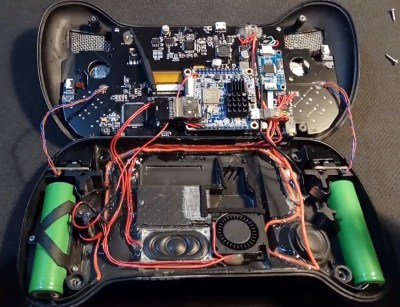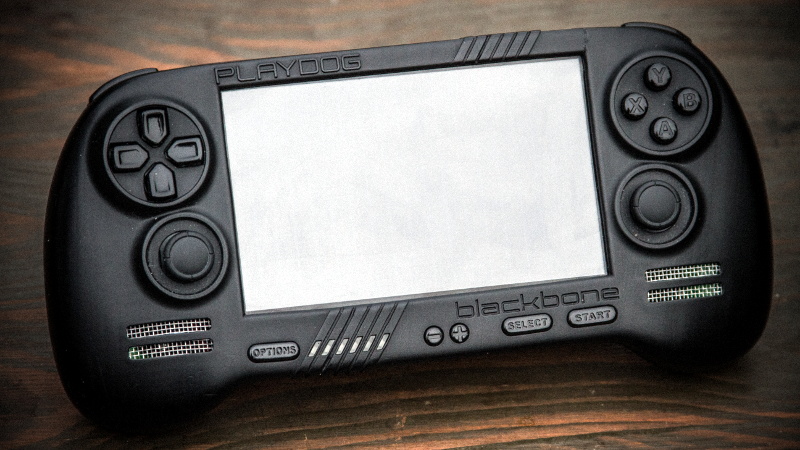It’s a good time to be a fan of classic video games. Most of us carry around a smartphone that’s more than capable of emulating pretty much everything from the 32-bit era on down, and if you want something a little more official, the big players like Sony and Nintendo have started putting out “retro” versions of their consoles. But even still, [Mangy_Dog] wasn’t satisfied. To get the portable emulation system of his dreams, he realized he’d have to design and build it himself.
The resulting system, which he calls the “Playdog Blackbone”, is without a doubt one of the most impressive DIY builds we’ve ever seen. While there are still some issues that he’s planning on addressing in a later version of the hardware, it wouldn’t be an exaggeration to say that there’s commercially available game systems that didn’t have half as much thought put into them as the Blackbone.
 Which is, incidentally, how this whole thing got started. The original plan was to buy one of those cheap emulation handhelds, which invariably seem to come in the form of a PSP clone, and fit it with a Raspberry Pi. But [Mangy_Dog] quickly realized that not only were they too small to get everything he wanted inside, but they also felt terrible in the hand. Since he wanted the final product to be comfortable to play, his first step was to design the case and get feedback on it from other retro game enthusiasts.
Which is, incidentally, how this whole thing got started. The original plan was to buy one of those cheap emulation handhelds, which invariably seem to come in the form of a PSP clone, and fit it with a Raspberry Pi. But [Mangy_Dog] quickly realized that not only were they too small to get everything he wanted inside, but they also felt terrible in the hand. Since he wanted the final product to be comfortable to play, his first step was to design the case and get feedback on it from other retro game enthusiasts.
After a few iterations, he arrived at the design we see today. Once he printed the case out on his SLA printer, he could move on with fitting all of his electronics inside. This takes the form of a custom PCB “motherboard” which an Orange Pi Zero Plus2 (sorry Raspberry fans) connects to. There’s actually a surprising amount of room inside the case, enough for niceties like dual speakers and a fan complete with ducting to keep the board cool.
Unsurprisingly, [Mangy_Dog] says a lot of people have been asking him if they can buy their own version of the Blackbone, and have suggested he do a crowdfunding campaign to kick off mass production. While he’s looking at the possibility of resin or injection molding the case so he can produce a few more copies, on the whole, his attention has moved on to new projects. Which frankly, we can’t wait to see.
If you’re interested in slightly more modern games, we’ve seen a number of handhelds based on “trimmed” Nintendo Wii’s which you might be interested in. While they might not have the sleek external lines of the Blackbone, the work that goes into the electronics is nothing short of inspirational.















Element 14 needs to hire this guy! We need a new Ben Heck!
Shut up and take my money!
Phenomenal!
Looking good.
I’m currently getting my handheld retro jollies on with retroleap https://github.com/mac2612/retroleap on a LeapsterGS which is pretty nice. 16 bit down though really and SNES needs work. Nes, Genesis/Megadrive and Mame2000 stuff is working great though. I’ve also got an apparently official earlier Sega retro handheld, which is a bit too small in the hand, and the screen is postage stamp scale.
There’s some decent support and activity going on around RetroOrangePi though, couple of android boxes can use it, low end cheapies, that you can find or $40 or less, which considering you get it with a case and PSU (and IR remote and HDMI cable ) is at least as good as piecing that together with an Opi board.
It needs a fan? Lame.
J/K, but it’s not ideal
please post a link to your fanless implementation.
my pi tablet has thermal issues sometimes. when i go back and re-design it for the pi4 (they had to move the damn ports) i will probably address that with some kind of active cooling. or maybe run a heat pipe to an external heat sink.
Maybe not idea but even the switch has a fan… I should say the fan only kicks in once the cpu is at 50c… and even then at a lower speed… however normal 16 bit gaming takes a while before the heat sink heats up above 50c…
I love the handheld form factor but I wish there were more handhelds that had a cartridge/expansion slot that I can put custom hardware in. (Kudos to the Supercon Badge!)
The user interfaces the retro community have created are awesome, I would love to interface my hardware with that.
I was trying to put my money where my mouth was when I built a custom RPI compute module board with an FPGA interface and an expansion slot but due to various issues some mine, some related to the assembly of the board. I can’t continue.
Here’s what it looked like before the LCD backlight driver fed a voltage spike back onto the 3.3v rail and blew out a bunch of ICs
http://cospandesign.com/Projects/RPCM%20Express/Rev%20A/RPCM%20Express%20LCD%20First%20Boot.jpg
Thats pretty sweet :D tbh Im kinda lucky i didnt have such a scary blow out as you had… You clearly dont need advice from me as your system (though with its hitch) looks pretty well advanced already. Heck you already went stright to USBc by the looks of it. Thats something I need to consider in a future version… As well as maybe QC (QT?) charging…
Looks like he borrowed heavily from the PSVITA for the case design. FWIW with custom firmware aka Enso the VITA is an extremely capable emulation platform and it has touchscreen/touchpad capability as well.
We’d welcome a person like Mangy_Dog on the sudomod.com Discord and forums <3
Reminds me of this guy, who has done an amazing job at doing a pi handheld as well.
https://instagram.com/robertdunnart?igshid=48sqoedeq0ah
What’s the battery life like? Only 2 hours powered from two 18650 cells?
I go into full details in the video… But around 5 and a half hours.